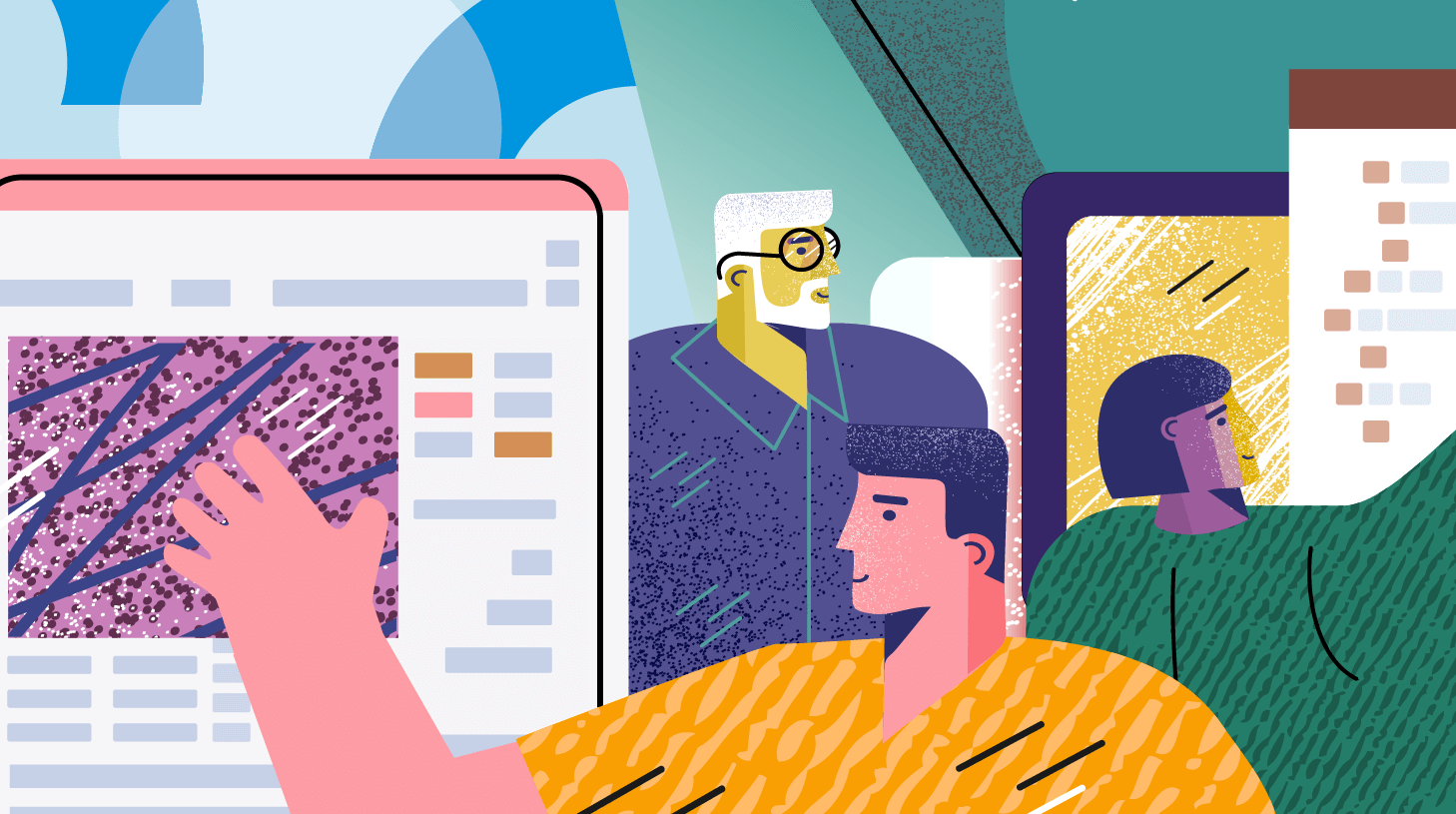6 workplace changes we can expect in the 2020s
As we go deeper into 2021, we’re ready to look back and reflect on the practices and solutions we all adopted during the pandemic. Since history is the best teacher, we can now firmly establish how to proceed through all the workplace changes, and ultimately move into the new normal.

The workplace changes we face are significant, and they primarily challenge our well-established MOs. Some of these issues are long overdue, so it might be that a global virus pandemic can bring about some positive changes to the table. One of the surprises we’re witnessing at the moment is the increasing value placed upon soft skills, across corporate levels.
There’s a lot more. Let’s take a look how the world of work has changed and will continue to change in the coming years.
- EX marks the spot
- ‘Moneyball’ HR
- IT takes the wheel
- Redefining departments
- Going (fully) remote
- Flexibility goes mainstream
1. EX marks the spot
Just like in Stevenson’s classic, Treasure Island, where X marks the treasure, EX is making a mark on the rapidly changing workplace around the world.
Employee experience (following previous hits such as UX and CX) is gaining momentum and moving front and center in the world of work., According to Josh Bersin, the value of the EX industry rose to $15 billion during the pandemic, which included surveys, feedback, case and knowledge management, and other developments.
In the past, EX was often an HR project on the back burner, mainly concerned with core metrics such as retention and productivity. It’s since moved through phases of development corresponding with business trends, including resource and time optimizations for a certain job, employee engagement, perks and benefits, and standard HR fare.
Now we’re seeing a fundamental shift in corporate culture, signaling long-term changes in EX through organizational overhauls.
While the brand-defining aspects of EX unfolded with bigger players long before the pandemic, including Google, Facebook and Apple. The new EX brings a deep culture shift in the business world and encompasses every stage of the employee lifecycle, starting with the initial candidate experience:
- The job ad and careers page
- The application process
- Screening call / one-way video interview
- Face-to-face interview (be it video or in person)
- Job offer and acceptance of offer
And then the experience of the role itself:
- Onboarding and training (including in remote environments)
- Working across and within teams
- The day-to-day of the role
- Management of the employee
- And every other element of the employee’s tenure with your organization
And finally, the overall employee experience lifecycle includes moving on to another job: how the news is received and handled, the transition phase, and even the exit interview.
EX efforts have recently transformed from passive observation to active action-taking, designing the full experience on top of the basic tenets of monitoring, surveying, and responding as needed. The pandemic has driven numerous challenges to the forefront.
Remote work has unique challenges for EX, and women are more affected than men – from parenting to racial issues to other inequalities underaddressed until now. From an EX design perspective, Diversity, Equity & Inclusion is top of mind.
As an HR practitioner, know that the advent of EX is penultimate in the list of workplace changes for the 2020s.
2. ‘Moneyball’ HR
Much like Brad Pitt in Moneyball, the new HR will not use their stats just for making reports, but also to pre-define strategies and come up with solutions for new challenges. This is a shift in focus from analysis to proactive planning.
The major upskills for HR specialists will focus mostly on soft skills: learning to identify problems and solutions faster, and implement them. This requires clear communication at all levels, especially in a remote setting. Clear discussion in a language that makes sense to the person you’re talking with will become crucial for a problem-solving approach to work.
Other skills that make HR a bigger player include:
- Analytical thinking and attention to detail – taking information from hiring managers, datasets, economic and hiring trends, etc., and turning that into meaningful guidance for your organization’s hiring plan
- Employee personas – i.e. defining your “perfect” employee and designing your recruitment strategy to attract those candidates
- Developing scenarios and strategies, and executing on them
These all need to be backed by a continuous influx of quality data. In doing so, the goal of the HR department will be to address individual requirements in more detail, but also to develop a strategic approach to potential problems and challenges, including safety and health issues of working from home, a plan to hire at scale, or the implementation of a new policy.
Oversimplifying again: the new HR needs to leverage people analytics while maintaining genuine connections on a human level.
2020 saw cuts in HR staff around the world, while the department faced entirely new challenges (which often came with a bigger workload). This is not exclusive to 2020. HR is already notoriously understaffed, even when dealing with an increased workload or a growing workforce. The pandemic has led to limited MOs in all types of businesses, leaving HR practitioners to find solutions on leaner budgets – and find them fast.
The new – sudden and unexpected – close collaboration with IT, business intelligence, and other data-focused teams might be the answer to these pain points, even in the long run. HR is now:
- Accessing and recruiting a new type of labor with different needs and requirements
- Needing solutions for new developments such as virus strains, vaccinations etc.
- Taking into account increasingly louder calls for greater diversity and equality;
- Crunching serious numbers into stats and reports.
The new processes and solutions need to be standardized, reliable and adaptable, since they need to accommodate for a diversified talent pool and new lines of communication. The need for quicker and better decision-making and problem-solving, with a leaner HR team and budget, while simultaneously incorporating new developments, is putting another department to the forefront – IT and data.
Brad Pitt’s character in Moneyball, Billy Beane, led his Oakland Athletics to a string of winning records year after year – all the more impressive considering his tight budget. One of the big developments in that story was the hiring of an expert data analyst (played by Jonah Hill in the film), who played an integral role in Beane’s data-focused approach to baseball.
As Jonah Hill’s character says: “Your goal shouldn’t be to buy players – your goal should be to buy wins.” Is Moneyhire next?
3. IT across all departments
The previous decade saw a steady rise in digital economy – with it, IT rose as a core function. IT is developing automations not to replace workers, but rather, to support them. As Josh Bersin says, “You’re getting augmented; you’re not getting replaced.”
The sudden shift to remote work in 2020 identified bottlenecks in various workflows: some long-awaited workplace changes were expedited to enable successful remote work. When executed well, it contributes to a better EX.
A much closer cooperation with other departments is benefiting IT experts as well: they are becoming multidimensional workers, not only IT specialists. Their soft skills are now more important than ever, especially in working with team leaders.
Closer cooperation with staff and the need to quickly overcome challenges adds value to everyone’s role. And the crucial goal is better and more uniform data distribution across all departments – including HR.
4. Redefining departments
As mentioned above, the newly evolved EX will require different functions and departments working more closely together in a flexible and streamlined manner.
Working remotely and managing labor – which can now be located across the globe – will require newly designed and defined workflows, including easy-to-follow roadmaps, flowcharts, clearly defined procedures, concept maps and similar fresh approaches to recruitment, interdepartmental projects, safety protocol implementation, and other standard business processes.
With the trend towards “flatter” organizational structures, employees now have a more direct influence and better engagement – they can work directly on solutions for their unique needs. These tasks often involve close collaboration with other departments. While this usually required a stroll down the hall to your colleague’s desk or office, things can become more challenging in a remote setting.
5. Going (fully) remote
Even as the pandemic becomes a thing of the past, workers will likely continue to be free to choose their locations. In fact, a Microsoft study states that 46% of them plan to move since work is no longer necessarily tied to a physical location. The shift to remote was also one of the biggest workplace changes we identified in our New World of Work survey.
This can work both ways: it means access to a larger talent pool for employers, but also a bigger job market for candidates. Likewise, tools are being developed to streamline recruitment at both ends, making remote work easier for candidates and HR specialists. Remote work also prompts dialogue on reimbursements for Internet charges, utilities and other home office-related expenses.
However, a physically distant work environment brings new challenges. It requires a proactive approach to re-skilling or up-skilling on all levels, especially soft/social skills, asynchronous communication, and resiliency. This will include both existing employees – especially HR, Management and IT – and job candidates.
Nevertheless, candidates and employees can now leverage all of the above for their own benefit, and it seems we have a new umbrella term for it: work flexibility.
6. Flexibility goes mainstream
The primary concern in 2020-propelled changes was productivity, as well as trust levels between employees and management. Both remained high throughout lockdowns.
Following this success, flexibility is becoming mainstream in 2021 and beyond: new work relations in a post-COVID place more value on empowering the labor force. The workers have more control of their time and careers, which leads to more engaged employees, which leads to better performance.
There’s a downside to it as well: working with ambiguity, always being ‘on standby’ for new measures and guidelines, etc. – but as is the case with every new trend and development, new processes and policies are introduced and adapted.
Again, like remote work, flexwork is less of a trend and more of a paradigm shift. In April 2020, Forbes found that 63% of leaders expected increased flexibility in time and location; by September 2020 that expectation grew to 87%.
Workplace changes are here to stay
From implementing safety protocols, to providing all the necessary hardware and software for remote work, to maintaining a sense of community, the leverage now shifts to the employee. The employee now expects these things from their employer. Not only that, but new candidates can leverage a host of newly-available options and requirements as well – as an HR practitioner, you need to stay on top of this with a candidate-first approach.
In the workplace itself, culture is transforming from mere ambient care to having proactive team members who are initiators, making sure all employees feel a connection to their work beyond their paychecks. This all means a better EX.
2021 marks a period of stabilization after the rollercoaster of 2020. It’ll define and consolidate what 2020 (sometimes hastily) set in motion. Let’s see how the new normal transforms into the next normal, paying close attention to our workplaces and work environments. With a touch of proactivity and a pinch of creativity, it could include resolving issues and progressing in areas in dire need of attention.
—
Silvana Carpineanu is a Marketing Specialist who works at mindomo.com. Driven by passion and creativity, she’s responsible for copywriting, advertising, SEO, and content creation. She does all of this knowing that for every minute spent organizing, an hour is earned.




